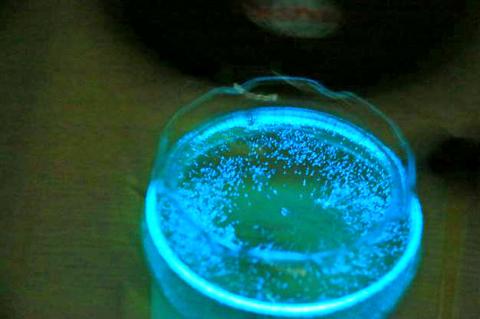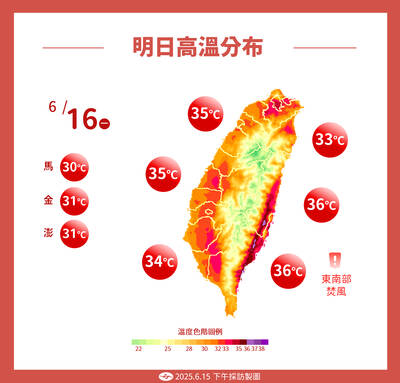A research team has developed a method to breed the bioluminescent marine organisms that cause the phenomenon known as a blue tide, which they plan to demonstrate at two aquariums on the Matsu islands.
Marine ecologists from National Taiwan Ocean University on Thursday unveiled their findings at a news conference in Pingtung County’s Kenting (墾丁).
Blue tides — also known as “blue tears” — are a naturally occurring bioluminescence in the sea around Matsu, a phenomenon that occurs between April and August which the county government has been promoting to attract tourism to the islands.

Photo courtesy of National Taiwan Ocean University
Chiang Kuo-ping (蔣國平), a professor of environmental biology and fisheries sciences at the university, said previous studies by the team had found that Noctiluca scintillans, or sea sparkles, was one of the organisms causing blue tides.
The team has been working on identifying the species that causes blue tides, understanding the conditions leading to their appearance, and finding ways to breed them in large numbers to address the difficulty in predicting their occurrence, which presents an obstacle for Matsu’s tourism, Chiang said.
The team linked sea sparkles to blue tides by isolating the species in cultures created from samples taken from the sea during blue tides, a conclusion that was later reinforced by RNA analysis performed with next-generation sequencing techniques, he added.
Following a year of research, the team developed a method for recycling 20 liters of sea water without losing the sea sparkles, which was the most challenging technical hurdle to commercial breeding of the organism, Chiang said.
The method allows researchers to breed the organism in tanks holding up to a tonne of water, he said.
After a series of tests conducted last year in the waters around Matsu, the team found that the intensity of blue tides was linked to algal blooms, or periods of rapid growth by microscopic algae, Chiang said, adding that the concentration of sea sparkles peaked toward the end of algal blooms.
The finding is consistent with a hypothesis that blue tides are the result of interactions in the marine food chain and are not caused by pollution, which distinguishes them from the Gulf of Mexico’s red tides, a phenomenon believed to be triggered by pollution and the breeding of harmful organisms, Chiang said.
The research was made possible by a grant from the Ministry of Education’s program for excellence in university education, National Taiwan Ocean University president Chang Ching-fong (張清風) said.
A blue tide habitat and tourism facility will be built at the site of the former Fisheries Research Institute facility on Nangan Island (南竿) and will be open to visitors by July, Chang said, adding that another facility on the university’s Matsu campus on Beigang Island will open next year.
Additional reporting by Yu Chao-fu

Taiwan is to have nine extended holidays next year, led by a nine-day Lunar New Year break, the Cabinet announced yesterday. The nine-day Lunar New Year holiday next year matches the length of this year’s holiday, which featured six extended holidays. The increase in extended holidays is due to the Act on the Implementation of Commemorative and Festival Holidays (紀念日及節日實施條例), which was passed early last month with support from the opposition Chinese Nationalist Party (KMT) and Taiwan People’s Party. Under the new act, the day before Lunar New Year’s Eve is also a national holiday, and Labor Day would no longer be limited

COMMITMENTS: The company had a relatively low renewable ratio at 56 percent and did not have any goal to achieve 100 percent renewable energy, the report said Pegatron Corp ranked the lowest among five major final assembly suppliers in progressing toward Apple Inc’s commitment to be 100 percent carbon neutral by 2030, a Greenpeace East Asia report said yesterday. While Apple has set the goal of using 100 percent renewable energy across its entire business, supply chain and product lifecycle by 2030, carbon emissions from electronics manufacturing are rising globally due to increased energy consumption, it said. Given that carbon emissions from its supply chain accounted for more than half of its total emissions last year, Greenpeace East Asia evaluated the green transition performance of Apple’s five largest final

Taiwan is to extend its visa-waiver program for Philippine passport holders for another year, starting on Aug. 1, Minister of Foreign Affairs Lin Chia-lung (林佳龍) said on Friday. Lin made the announcement during a reception in Taipei marking the 127th anniversary of Philippine independence and the 50th anniversary of the establishment of the Manila Economic and Cultural Office (MECO) in Taiwan, the Ministry of Foreign Affairs said. The decision reflected Taiwan’s commitment to deepening exchanges with the Philippines, the statement cited Lin as saying, adding that it was a key partner under the New Southbound Policy launched in 2016. Lin also expressed hope

Temperatures in New Taipei City’s Sindian District (新店) climbed past 37°C yesterday, as the Central Weather Administration (CWA) issued heat alerts for 16 municipalities, warning the public of intense heat expected across Taiwan. The hottest location in Taiwan was in Sindian, where the mercury reached 37.5°C at about 2pm, according to CWA data. Taipei’s Shilin District (士林) recorded a temperature of 37.4°C at noon, Taitung County’s Jinfeng Township (金峰) at 12:50 pm logged a temperature of 37.4°C and Miaoli County’s Toufen Township (頭份) reached 36.7°C at 11:40am, the CWA said. The weather agency yesterday issued a yellow level information notice for Taipei, New